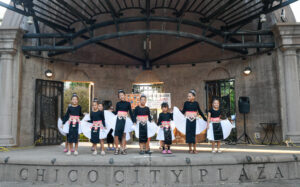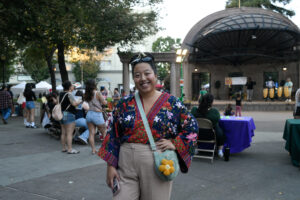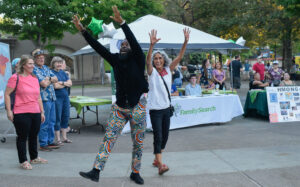On stage at City Plaza, 13 Hmong girls from Oroville, dressed in traditional attire, performed a dance to the Hmong song, “Hello, Hello, I Like You.” Below the stage, audience members took pictures, recorded video and applauded. This was the opening performance at the Sept. 12 Homeland Celebration event.

“Our girls love to perform. It’s a good experience for them,” Passion Chue told ChicoSol. She works as a program supervisor at Oroville’s Hmong Cultural Center and oversees all youth programs, including the dancing team. Chue said the girls practice dancing at the center after school in a limited space and without mirrors.
Chue decided to bring her dancers to the event when she received the invitation about one month ago. “Even though the population of Hmong people is somewhat big in Butte County, a lot of people still don’t know our culture,” said Chue.
Her colleague, Pae Xiong, tabled during the event. Xiong said she was delighted when some people walked to their table and showed interest in Hmong embroidery. “It’s still difficult for Hmong people to be seen. We are trying to tell people that we exist, and let people understand how we live our lives,” Xiong said.

Sonny Baird, one of the event organizers, told ChicoSol that the idea for the event sprouted within his church group. The group’s goal was to have organizations from around Chico set up tables to showcase their cultural backgrounds. However, Baird emphasized that the Homeland Celebration was not a church-sponsored event; it was organized independently. Organizers researched online, looked into the local cultures, identified the groups representing them, and then sent out emails. Eventually, 10 tables and six performances were scheduled.
Baird said they didn’t end up including groups from every continent and would like to see more South American and European groups in the future. The biggest challenge was “getting on people’s schedule early enough because they all participate in different events as well.”
Since they didn’t have enough budget to advertise, they chose to run Homeland at night market time so that people who come to the market could stop by and enjoy the event. Organizing the event only cost them about $500 dollars, said Baird. “We already had the tables and chairs; everybody brought their own stuff. The lights were the most expensive part.”
The co-organizer, Tamba Sellu, played the drum on stage to showcase the culture of his homeland, Sierra Leone. He also invited his friends to perform with him, including Damilola Afolabi, who danced to the rhythm of Sellu’s drumming.

Afolabi is from Nigeria, where he said there are more than 200 unique tribes. Growing up in such a diverse environment made him appreciate cultural diversity even more. “When I come to new places and hear people talk about their culture, my heart bubbles. And this event allows me to see the identity and rich heritage of different people living in our communities, and to get a taste of the world in this part of America.”
Afolabi became the star of the Sept. 12 event. He danced from the stage to the square, with children joining in, followed by more and more adults, including a few elders. After his performance, a few kids ran up and gave him a hug.
Afolabi appreciates Chico’s diversity.
“Chico gives me the impression that I’m in a small city, but I am also in a big city,” he said.
Lily Bergeron, 21, president of the Filipino American Student Organization at Chico State, said she was a bit nervous because they usually hold tabling events on campus, but this time they were trying to spread awareness of Filipino culture to the general public.

Handgame Set, who sat at the table representing the Mechoopda Indian Tribe, said that his favorite artifact on display was the clapper stick, a musical instrument in his tribe. He had brought a stereo to the event and played a song for ChicoSol, where the clapper stick produced a crisp, beautiful sound. “When I play the instrument, the dancers start to dance,” he said with a smile.
Sam Westover, 22, who grew up in the Chico area, said it was her first time at such an event in this area. “It’s really cool to get people together and know more about each other,” she said.
Yucheng Tang is a reporter at ChicoSol and a California Local News Fellow.

Is this paper going to oppose the Butte County Measure H the sales tax increase?
This will be the second sales tax increase we’ve had in Chico in the last couple years, increasing our sales tax from 7.25 to 9.25%.
THAT WILL BE THE HIGHEST IN THE NORTH STATE! HIGHER THAN SACRAMENTO, ROSEVILLE, STOCKTON, PLACERVILE, ETC. THIS IS CRAZY!
Also, sales taxes ARE REGRESSIVE AND HURT THE POOR AND WORKING CLASS THE MOST!
WHY DIDN’T CHICO SOL DO ANYTHING TO OPPOSE THE CHICO SALES TAX INCREASE AND NOW THIS COUNTY SALES TAX INCREASE???
DOESN’T CHICO SOL CARE ABOUT POOR PEOPLE???
I agree with everything you said – but I support the sales tax increase. The reason is that local abilities to tax the wealthy have used their power to hamstrung through State and Federal law to allow only those tax increases that burden the poor and middle class. Until we begin to insist that the wealthy pay their fair share this is the only avenue available for our local communities.
9.25% is what the people of Chico and Oroville will pay, Paradise will be 8.75% every one else at least 8.25%. THAT IS CRAZY! AND 9.25% IS ESPECIALLY OUTRAGEOUS. NO OTHER COUNTIES AROUND HERE, NOT EVEN SACRAMENTO, HAVE THEIR OWN SALES TAX BUT BUTTE COUNTY WANTS ONE. WHY? SO COUNTY BUREAUCRATS LIKE ANDY PICKET CAN HAVE PENSIONS WORTH MILLIONS! TAXING POOR PEOPLE TO ENRICH BUREAUCRATS AND NO ONE CARES. WHY?
Its so wonderful to hear of our diverse neighbors! Thanks for this reporting. I bike in the orchard areas and love seeing the Hmong farms, which are always obvious from their range of varied crops all together in a mid-sized plot, and often edged with flowers to be cut for the colorful farmer’s market bouquets.
I also consider how the Hmong and other small and native farmers are fairing given as I watch the orchards quickly change: so many are being torn out and replanted with newer hybrids, more closely placed for higher yields, and less variety — no walnuts, lots of almonds — for the greatest financial output possible. Not to mention the higher-production irrigation systems made possible by larger ag interests.
I wonder how we can help our Hmong and others thrive in their human-sized fields of endeavor, and to maintain economic independence.